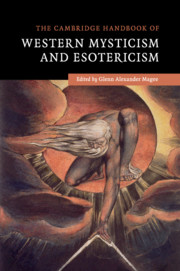Book contents
- Frontmatter
- Dedication
- Contents
- Acknowledgments
- Editor's Introduction
- List of contributors
- I ANTIQUITY
- II THE MIDDLE AGES
- III THE RENAISSANCE AND EARLY MODERNITY
- IV THE NINETEENTH CENTURY AND BEYOND
- V COMMON THREADS
- 30 Alchemy
- 31 Astrology
- 32 Gnosis
- 33 Magic
- 34 Mathematical Esotericism
- 35 Panpsychism
- 36 Sexuality
- Suggestions for Further Reading
- Index
- References
34 - Mathematical Esotericism
from V - COMMON THREADS
Published online by Cambridge University Press: 05 May 2016
- Frontmatter
- Dedication
- Contents
- Acknowledgments
- Editor's Introduction
- List of contributors
- I ANTIQUITY
- II THE MIDDLE AGES
- III THE RENAISSANCE AND EARLY MODERNITY
- IV THE NINETEENTH CENTURY AND BEYOND
- V COMMON THREADS
- 30 Alchemy
- 31 Astrology
- 32 Gnosis
- 33 Magic
- 34 Mathematical Esotericism
- 35 Panpsychism
- 36 Sexuality
- Suggestions for Further Reading
- Index
- References
Summary
Theology, Ethics, Cosmology
“Number symbolism” refers to a “qualitative” approach to number and mathematical objects in general. It is backed by what is known as “correlative thinking” and operates according to a network of analogies linking the quantitative values of mathematical entities to a vast array of correspondences throughout the many levels of the so-called Great Chain of Being. It is also a universal cultural phenomenon, likely to have existed from time immemorial. But it should not be confused with “numerology,” a term that has mainly come to designate contemporary methods of a pseudo-divinatory character, which do not concern us here.
Within Western culture, to which we shall limit ourselves in this essay, explicit considerations pertaining to “arithmology” (or qualitative number) first appear with the Greeks – insofar, that is, as extant documents are concerned.
Although it is clear that correlative thinking, mathematical symbolism, and the worldview they both depend on pertain to a type of archaic “wisdom” predating Greek civilization, it is nevertheless the case that the few truly arithmological texts that have come down to us date from no earlier than the late Hellenistic period. Still, one must take into account the fact that the name of Pythagoras (ca. 570–490 BCE) was already synonymous in Ancient Greece with a “philosophy of number.” It appears that the Pythagorean school, which vanished around the end of the fourth century BCE, never felt compelled to draw a clear distinction between mathematical research, as we would understand it, and mystical speculations about arithmetic and geometry. Both Proclus (412–485 CE) and Damascius (ca. 470–535 CE) ascribe to Philolaus of Croton (fl. ca 450 BCE), one of the main representatives of the early Pythagorean movement, a discourse on “theological geometry,” which correlates the respective angles of the triangle and square to the same number of masculine and feminine Olympian deities, to underline the sovereignty of the duodenary (3 × 4) associated with the supreme god Zeus. This appears to confirm the presence of symbolic perspectives from the beginning of the school, inasmuch as it is feasible to distinguish between supposedly “original” material and later, “traditional” developments.
What appears to us, accordingly, as a mixture of scientific and symbolic perspectives results in a general doctrine of cosmic harmony, partly expressed in mathematical concepts and correspondences that may have exerted a certain influence on Plato.
- Type
- Chapter
- Information
- The Cambridge Handbook of Western Mysticism and Esotericism , pp. 405 - 416Publisher: Cambridge University PressPrint publication year: 2016



